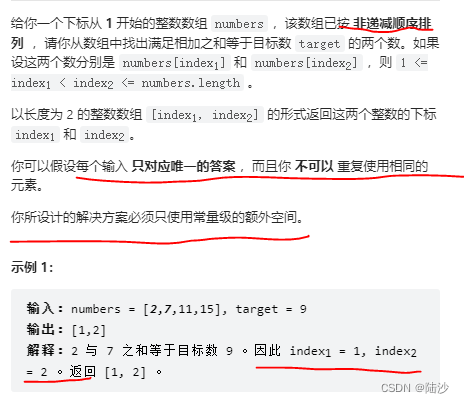双指针有两种:1)快慢指针:两个指针向同一个方向前进,一快一慢;2)左右指针:两个指针相向或相背移动
快慢指针
【简单】26. 删除有序数组中的重复项
https://leetcode.cn/problems/remove-duplicates-from-sorted-array
给你一个 升序排列 的数组 nums ,请你 原地 删除重复出现的元素,使每个元素只出现一次 ,返回删除后数组的新长度。元素的 相对顺序 应该保持 一致 。
输入:nums = [1,1,2]
输出:2, nums = [1,2,_]
解释:函数应该返回新的长度 2 ,并且原数组 nums 的前两个元素被修改为 1, 2 。不需要考虑数组中超出新长度后面的元素。
思路:使用下标作为指针。
class Solution:
def removeDuplicates(self, nums: List[int]) -> int:
slow = fast = 0
while fast < len(nums):
if nums[slow] != nums[fast]:
# +1 是为了让[0,slow]都没有重复,修改的是后一个位置
slow += 1
nums[slow] = nums[fast]
fast += 1
# 要求返回修改后数组的长度
return slow + 1
【简单】83. 删除排序链表中的重复元素
给定一个已排序的链表的头 head , 删除所有重复的元素,使每个元素只出现一次 。返回 已排序的链表 。
https://leetcode.cn/problems/remove-duplicates-from-sorted-list/
思路:跟数组这个完全一样!!!
# Definition for singly-linked list.
# class ListNode:
# def __init__(self, val=0, next=None):
# self.val = val
# self.next = next
class Solution:
def deleteDuplicates(self, head: Optional[ListNode]) -> Optional[ListNode]:
if head == None or head.next == None:
return head
fast = slow = head
while fast != None:
if fast.val != slow.val:
slow.next = fast
slow = slow.next
fast = fast.next
# 此时已经slow后面是重复元素了,所以给它连到None上去
# 比如1→2→2,slow最后停在第一个2上
slow.next = None
return head
【简单】27. 移除元素
https://leetcode.cn/problems/remove-element
给你一个数组 nums 和一个值 val,你需要 原地 移除所有数值等于 val 的元素,并返回移除后数组的新长度。
不要使用额外的数组空间,你必须仅使用 O(1) 额外空间并 原地 修改输入数组。
思路:双指针。快指针一路向前,如果是val,那么直接跳过去;如果不是val,将快指针值赋值到慢指针位置,然后移动慢指针。
class Solution:
def removeElement(self, nums: List[int], val: int) -> int:
if len(nums) == 0: return 0
fast = slow = 0
while fast < len(nums):
if nums[fast] != val:
nums[slow] = nums[fast]
slow += 1
fast += 1
return slow
【简单】283. 移动零
https://leetcode.cn/problems/move-zeroes/
给定一个数组 nums,编写一个函数将所有 0 移动到数组的末尾,同时保持非零元素的相对顺序。
请注意 ,必须在不复制数组的情况下原地对数组进行操作。
思路:这题直接复用上面的代码,使val=0即可。然后再将slow后面的元素设为0
class Solution:
def moveZeroes(self, nums: List[int]) -> None:
"""
Do not return anything, modify nums in-place instead.
"""
if len(nums) == 1: return
fast = slow = 0
while fast < len(nums):
if nums[fast] != 0:
nums[slow] = nums[fast]
slow += 1
fast += 1
while slow < len(nums):
nums[slow] = 0
slow += 1
左右指针
二分查找:基础版
def binarySearch(nums:list[int], target:int)->int:
left = 0
right = len(nums) - 1
# 注意这里有个=
while left <=right:
mid = (right + left) // 2
if nums[mid] == target:
return mid
elif nums[mid] < target:
left = mid + 1
else:
right = mid - 1
return -1
其中计算mid可以换成: left+(right-left)//2 这样可以防止数值过大时溢出
【中等】167. 两数之和 II - 输入有序数组
https://leetcode.cn/problems/two-sum-ii-input-array-is-sorted/

思路:看到非递减、有序之类的字眼立刻想到能不能用二分查找。。
class Solution:
def twoSum(self, numbers: List[int], target: int) -> List[int]:
left = 0
right = len(numbers) - 1
# 不能重复使用
while left < right:
s = numbers[left] + numbers[right]
if s == target:
return [left + 1, right + 1]
elif s < target:
left += 1
else:
right -= 1
就地反转数组or字符串,判断回文串都是利用相向的双指针。不再赘述。
二分查找-找到左边界版
def binarySearchLeftBound(nums:list[int], target:int)->int:
left = 0
right = len(nums) - 1
while left <= right:
mid = left + (right - left) // 2
if nums[mid] == target:
right = mid - 1 # 不断向左收缩,找左边界
elif nums[mid] < target:
left = mid + 1
else:
right = mid - 1
if left == len(nums): return -1
if nums[left] == target: return left
else: return -1
二分查找-找到右边界版
def binarySearchLeftBound(nums:list[int], target:int)->int:
left = 0
right = len(nums) - 1
while left <= right:
mid = left + (right - left) // 2
if nums[mid] <= target:
left = mid + 1 # 不断向右
else:
right = mid - 1
if left -1 < 0: return -1
if nums[left-1] == target: return left-1
else: return -1
【中等】34. 在排序数组中查找元素的第一个和最后一个位置
https://leetcode.cn/problems/find-first-and-last-position-of-element-in-sorted-array/
给你一个按照非递减顺序排列的整数数组 nums,和一个目标值 target。请你找出给定目标值在数组中的开始位置和结束位置。如果数组中不存在目标值 target,返回 [-1, -1]。你必须设计并实现时间复杂度为 O(log n) 的算法解决此问题。
示例 1:
输入:nums = [5,7,7,8,8,10], target = 8
输出:[3,4]
思路:直接调用上面的函数即可。另外加对[]的判断。
class Solution:
def searchLeftBound(self, nums: List[int], target: int) -> int:
if nums == []: return -1
left = 0
right = len(nums) - 1
while left <= right:
mid = left + (right - left) // 2
if nums[mid] >= target:
right = mid -1
else:
left = mid + 1
if left == len(nums) or nums[left] != target: return -1
return left
def searchRightBound(self, nums: List[int], target: int) -> int:
if nums == []: return -1
left = 0
right = len(nums) - 1
while left <= right:
mid = left + (right - left) // 2
if nums[mid] <= target:
left = mid + 1
else:
right = mid - 1
if left < 1 or nums[left-1] != target: return -1
return left-1
def searchRange(self, nums: List[int], target: int) -> List[int]:
return [self.searchLeftBound(nums, target), self.searchRightBound(nums, target)]
【简单】剑指 Offer 53 - I. 在排序数组中查找数字 I
https://leetcode.cn/problems/zai-pai-xu-shu-zu-zhong-cha-zhao-shu-zi-lcof
统计一个数字在排序数组中出现的次数。
示例 1:
输入: nums = [5,7,7,8,8,10], target = 8
输出: 2
示例 2:
思路:还是直接复用二分查找左右边界的函数。这里直接写主函数了。
def search(self, nums: List[int], target: int) -> int:
left = self.searchLeftBound(nums, target)
# 如果左边界已经找不到,那没必要继续查找右边界了
if left == -1: return 0
right = self.searchRightBound(nums, target)
return right - left + 1
【简单】278. 第一个错误的版本
https://leetcode.cn/problems/first-bad-version/

# The isBadVersion API is already defined for you.
# def isBadVersion(version: int) -> bool:
class Solution:
def firstBadVersion(self, n: int) -> int:
left = 1
right = n
while left < right:
mid = left + (right - left) // 2
# 答案在[left, mid]
if isBadVersion(mid):
right = mid
else:
left = mid + 1
return left
【中等】5. 最长回文子串
https://leetcode.cn/problems/longest-palindromic-substring
给你一个字符串 s,找到 s 中最长的回文子串。
示例 1:
输入:s = “babad”
输出:“bab”
解释:“aba” 同样是符合题意的答案。
思路:这次是从中心向两侧扩展。相背而行的双指针。
class Solution:
# 计算以[left,right]为中心的最长回文子串
def findWithBound(self, s:str, left:int, right:int) -> str:
# 下标合法且满足回文要求,则向两侧扩展子串
while left >= 0 and right < len(s) and s[left] == s[right]:
left -= 1
right += 1
return s[left+1:right]
def longestPalindrome(self, s: str) -> str:
ans = ""
for i in range(len(s)):
# 如果字串长度为奇数,中心就是自己
odds = self.findWithBound(s, i, i)
# 如果字符串长度为偶数,那么输入相邻的两个
evens = self.findWithBound(s, i, i + 1)
# 选择长度最长的那个更新ans值
if len(odds) > len(ans):
ans = odds
if len(evens) > len(ans):
ans = evens
return ans
【中等】647. 回文子串
https://leetcode.cn/problems/palindromic-substrings/
给你一个字符串 s ,请你统计并返回这个字符串中 回文子串 的数目。
输入:s = “aaa”
输出:6
解释:6个回文子串: “a”, “a”, “a”, “aa”, “aa”, “aaa”
思路:照着上题的改,只不过每次得到回文的时候都+1
class Solution:
def findWithBound(self, s:str, left:int, right:int) -> int:
cnt = 0
while left >= 0 and right < len(s) and s[left] == s[right]:
left -= 1
right += 1
# 表示此时有一个回文子串
cnt += 1
return cnt
def countSubstrings(self, s: str) -> int:
cnt = 0
for i in range(len(s)):
cnt += self.findWithBound(s,i,i) + self.findWithBound(s,i,i+1)
return cnt